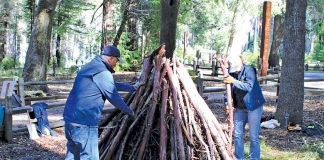I spent my holiday in a most remarkable place. I drove through miles of the Stanislaus National Forest devastated by the Rim Fire, the third largest wildfire in California history.
I played in the snow at Crane Flat before descending into the Yosemite Valley, where water flowed freely after several years of drought. Nature is renewing herself as she always has. At this time of year, it’s especially relevant to look the process of rebuilding. Take a lesson from nature.
There is much controversy about the dams and reservoirs that supply drinking water. Should some – like the Hetch Hetchy reservoir that sits within the boundaries of Yosemite National Park – be restored to the pristine valley that was there originally?
It’s a complicated question, one that I pondered while hiking over the O’Shaughnessy Dam on the way to Wapama Falls. With a storm brewing, I made my way along the rim of this breathtaking, glacier-carved valley, surrounded by towering granite cliffs much like Yosemite Valley.
Bright-orange Sierra newts waddled across the trail looking for a crevice in a rock or log. Their skin secretes a toxin which is a hundred times more deadly than cyanide and is being studied at Stanford University as a pain medication.
Under some burned Black Oaks, I found a lush stand of Tufted Rock ferns described by John Muir when he hiked and camped in the area in 1873 as having “rare beauty”.
Hetch Hetchy is a lesson in the value of a watershed – this one being supported by the Upper Tuolumne River.
With much of the forest and chaparral destroyed by the Rim Fire, the forest surrounding the reservoir is starting to come back with succession plants like the resprouting of California black oak, ceanothus, and manzanita in the lower elevations and Ponderosa pine, dogwood and incense cedar in the higher areas.
Forest rejuvenation began immediately after the fire went out. Native wood-boring beetles rapidly colonize burned areas while black-backed woodpeckers depend on them as a high-protein food source – eating over 13,000 beetle larvae every year.
Remote-sensing satellite images indicate that virtually all the vegetation is dead on nearly 40 percent of the burned area. Chaparral and oaks will resprout, but ecologists say it could take 30 to 50 years for the forest to reestablish itself. The fire scorched some of the last remaining old growth in the Stanislaus National Forest and some 78,000 acres of Yosemite National Park.
Recent rains and snowfall have been welcome in all of California, but it is especially important in a burned forest.
The Yosemite Valley was spared the brunt of the fire, but not the effects of the drought of the past several years.
Water is flowing in the Merced River and the waterfalls are spectacular, but the light dusting of snow on El Capitan, Half Dome, and other famous peaks are mostly picturesque. It’s the snowpack in the Sierra that provides so much of the drinking water for Californians and the snow has mostly been falling at the higher altitudes so far this season.
Still, the reservoir levels are increasing with each storm and if Mother Nature can keep up the good work between now and April, we’ll be in better shape than the last couple of drought years.
The California Department of Water Resources has published electronic readings of the snow survey which show that its water equivalent is only 54 percent of the average statewide so far.
The winter’s first manual measurement of the snow pack was set for Tuesday, Dec. 30. They will publish the findings on their website. Reservoir levels and precipitation levels can also be found on the CDEC website at http:/cdec.water.ca.gov/cdecapp/snowapp/sweq.action
We gardeners approach the New Year with optimism and hope. Here’s to 2015 and all that it brings.
– Jan Nelson, a landscape designer and California certified nursery professional, will answer questions about gardening in the Santa Cruz Mountains. E-mail her at ja******@*ol.com, or visit www.jannelsonlandscapedesign.com to view past columns and pictures.











